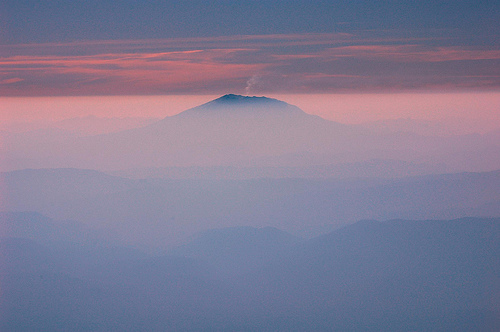From the Community: ecological research in July
Resistance to Bt crops, chaotic red queen, balancing research near Mount Saint Helens, biodiversity and species coexistence and camouflage in polymorphic Pygmy grasshoppers. Here is open-access research from the first week in July.
Cropping up: From the article “Managing resistance to Bt crops in a genetically variable insect herbivore, Ostrinia nubilalis” by Megan E. O’Rourke, Cornell University, in Ecological Applications:
Insect races within a single species may have very different ecologies despite being morphologically indistinguishable. This can have important implications for managing agricultural pest species that are composed of multiple races. The European corn borer is a classic example of an economically important agricultural pest for which management strategies and regulatory policies have largely ignored the potential differences between known host races.
Chaotic red queen: In “Chaotic Red Queen coevolution in three-species food chains,” Fabio Dercole from Politecnico di Milano and colleagues write in Proceedings of the Royal Society Biological Sciences:
Antagonistic coevolution describes the reciprocal evolutionary interactions between populations belonging to an ‘exploiter’ (such as a predator or a parasite) and a ‘victim’ (such as a prey or a host). It is a change in the genetic make-up of a population in response to a genetic change in the antagonistic population. Antagonistic interactions have the potential to drive coevolutionary dynamics of adaptive traits: an evolutionary advantage gained by one antagonist is often associated with a disadvantage for the other antagonist, and may therefore prompt a counteradaptation.
Extreme field work: Author Douglas Larson recounts in “Science After the Volcano Blew” from American Scientist:
On May 20, 1980, two days after the catastrophic eruption of Mount St. Helens, U.S. Geological Survey scientists landed in a helicopter near the volcano’s base, a short distance from what should have been the south shore of Spirit Lake. The lake, just 8 kilometers north-northeast of the volcano, was the largest of dozens of subalpine lakes battered by the eruption. Unable to see much that resembled a lake, the scientists suspected that Spirit Lake had either boiled away or was buried by avalanche debris. Further investigation revealed that the lake had survived, but it looked more like land than water because thousands of logs, tons of volcanic ash and other rubble blanketed its surface.
The riches: In “More than ‘More Individuals’: The Nonequivalence of Area and Energy in the Scaling of Species Richness” from The American Naturalist, Allen H. Hurlbert from University of North Carolina, Chapel Hill and Walter Jetz from University of California, La Jolla start the article:
Understanding spatial variation in species richness has long been a central focus of ecology, but while we have gained a solid appreciation for empirical patterns, less headway has been made in evaluating underlying mechanisms. The difficulty is understandable given that geographical richness patterns are likely driven by a suite of ecological, evolutionary, and historical factors, many of which are statistically and biologically correlated. Recent directions in macroecological research have focused on exploring how potential mechanisms might unite species richness patterns with other canonical patterns in ecology.
Pygmy camouflage:
Published July 6, 2010 in PLoS one, the authors of “Camouflage Effects of Various Colour-Marking Morphs against Different Microhabitat Backgrounds in a Polymorphic Pygmy Grasshopper Tetrix japonica” said:
Colour-marking polymorphism is widely distributed among cryptic species. Moreover, some species are highly polymorphic in colour and markings even within a single population. Camouflage is one of the most common forms of defensive colouration against visually hunting predators. Many animal species have contrasting body markings; despite this, they often appear to be rather cryptic against their natural backgrounds, at least to the human eye.
Photo Credit: sagebrush photography
